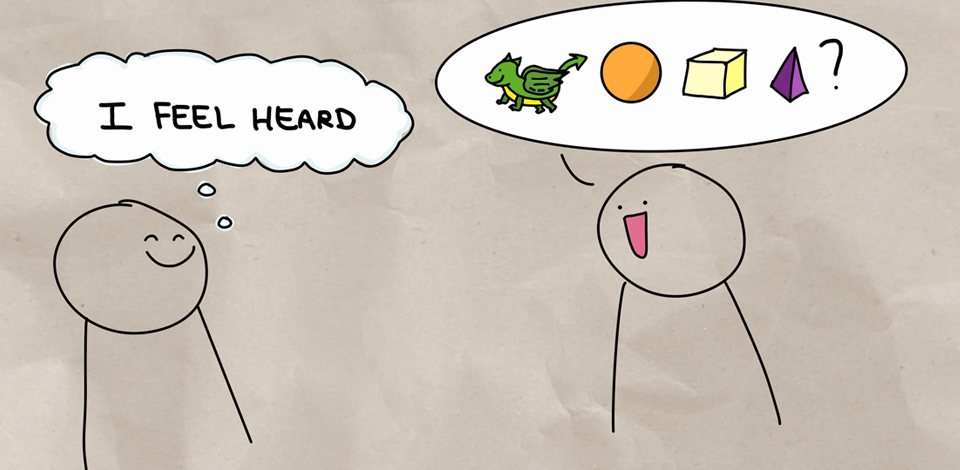What is effective communication?
You want to take steps to resolve the communication issues among your camp participants and help them develop the skills they need to communicate effectively. In this unit, you'll learn about effective communication and its importance in a technology workspace.
Examine the importance of effective communication
People communicate to understand and be understood. When you don't feel understood, you can feel deflated and minimized. Poor communication can damage relationships, erode trust, and negatively affect your ability to contribute. In contrast, feeling understood can be empowering and can help you contribute and move forward.
Knowing how to effectively communicate is an important skill in all aspects of your life—at home, in school, at work, or wherever you need to interact with other people. But what does "communication" mean to you? Perhaps you think of it as talking to someone, giving a speech, or writing an email. But getting your point across is only one part of the communication process.
Practice active listening to communicate effectively
To communicate effectively, you need to set aside your own preconceived notions or ideas and focus on what the other person is saying. Giving someone your complete attention to understand is called active listening. When you're practicing active listening, you're demonstrating respect for the other person and their ideas. Active listening contributes to building trust, which is a crucial part of effective communication.
To understand what active listening is all about, review the following short video.
When you engage in active listening, you need to:
- Create space. Slow down and create space to listen with your full attention:
- Listen to what they're saying rather than thinking about what you want to say next. If you find yourself doing that, reorient your attention to what they're saying.
- Give them time to finish their thoughts. Allow space after they finish to consider what they've said instead of jumping in to talk the moment they stop speaking.
- Mirror what they said. Tell the speaker what you think they said in your own words—a technique called mirroring. You can ask, "Can I repeat back to make sure I'm with you?" Mirroring signals that you're listening, but also ensures that you understand correctly.
- Try on their perspective. Try to understand their point of view to gain a deeper sense of their position, even when you disagree with what they're saying.

Differentiate between intention and impact
Sometimes, even though you might be well intentioned in your message, the recipient still receives the wrong message. This misunderstanding can be caused by many factors. It includes your choice of words, non-verbal cues, or even the recipient's frame of mind—maybe they're just having a bad day. Assuming that the other person has good intentions can help you both slow down and listen to each other with purpose.
When you're actively listening to somebody, you don't need to respond immediately after they finish speaking. Instead of jumping to a conclusion or giving advice, take a pause to reflect on their words and digest their point of view. As you mentally form a response to their words, you can continue to consider their perspective and how your response might affect them.

Examine the impact of effective communication
Recall the first example of the coding camp where you're teaching coding. You observe two participants working on a project. Participant A notices a flaw in the code that Participant B has written and tells them, "Your code is wrong. That's why this isn't working." Participant B is upset and responds defensively by saying, "It's not wrong. I spent all morning on it." Participant A is surprised by the negative reaction and says, "Don't be so sensitive. I was just trying to help."
What could be improved in this interaction? Consider the following reactions:
- Participant A could clarify that their intention is to help Participant B with their code.
- Participant B could assume good intent instead of reacting in a defensive way, and ask clarifying questions to find out more about the perspective of Participant A.
Notice how different this exchange would be with these alternate choices by both participants:
- Participant A: "I noticed that this part of the code isn't working. I worked on something like this last week, and I think I might be able to help. If it's okay with you, I'd like to work on it with you and we can get it working together."
- Participant B: "That would be great. Can you show me which part isn't working? I worked on this all morning, and I'm really frustrated with it. I could sure use the help."
With just a few changes from both participants, the interaction moves from a place of frustration and hurts feelings to a place of collaboration and trust.
In one-on-one interactions, or when you interact in a group setting such as a team, remember to:
- Actively listen to each other.
- Identify the other person's motivation.
- Consider the other's perspective.
Active listening can help establish trust, and help you feel connected and supported. By truly listening to understand one another, you can build more meaningful relationships and collectively feel empowered to achieve more.